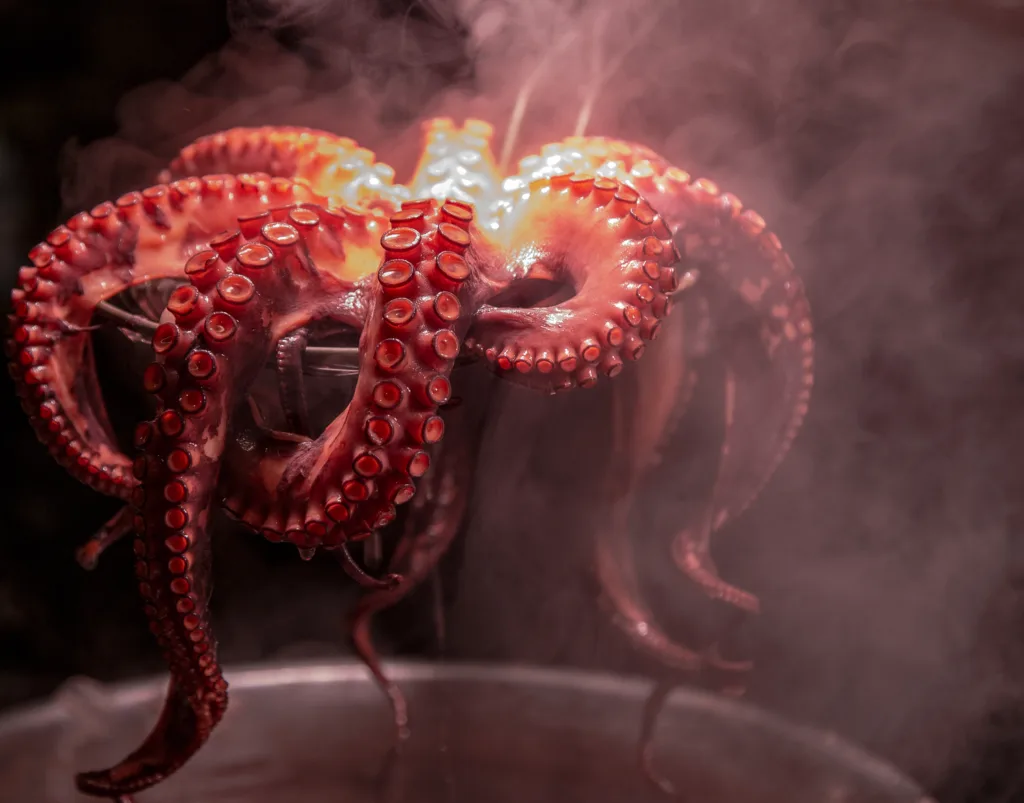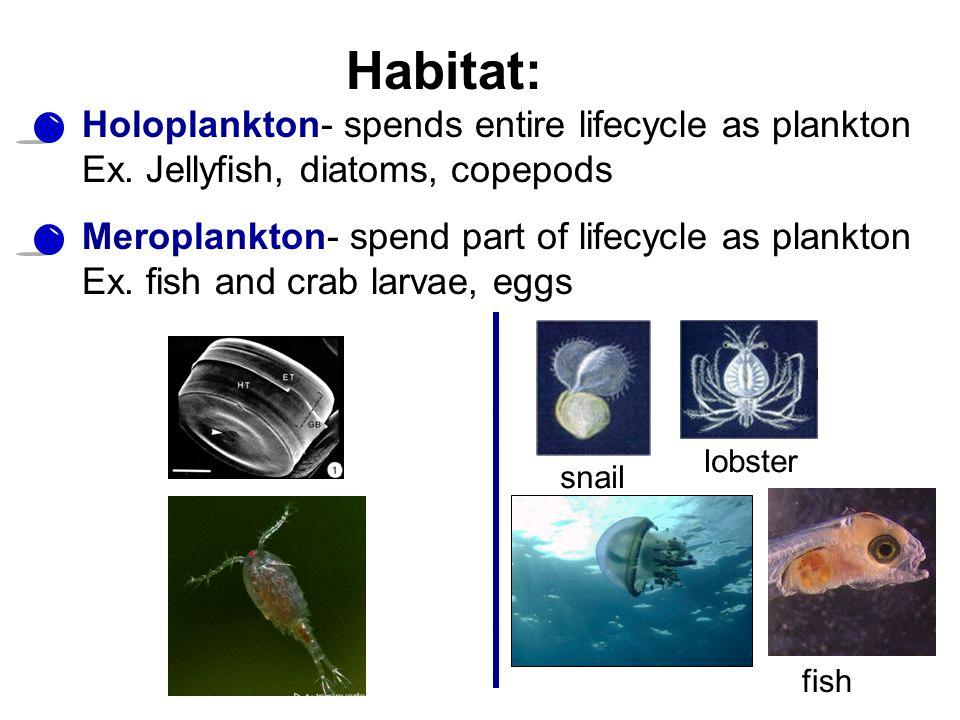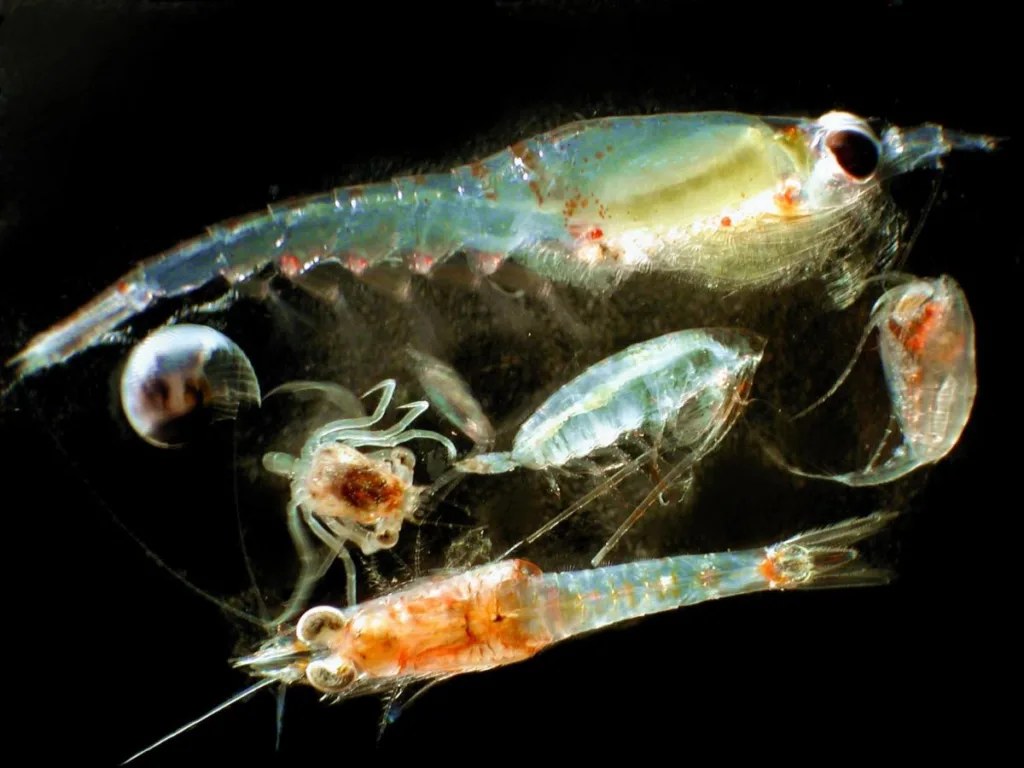The ocean is home to a variety of living organisms, from the smallest plankton to the largest whales. Among these organisms are the holoplankton and meroplankton, two groups that are often confused with each other. Although they both belong to the plankton, the differences between them are significant. In this article, we will delve deeper into these two groups and explore their unique characteristics.
Holoplankton, as the name suggests, spend their entire lives as part of the plankton. These organisms are permanent members of the planktonic community and include krill, copepods, vrious pelagic sea snails and slugs, salps, jellyfish, and a small number of marine worms. They are typically small and have adaptations that allow them to survive in the open ocean, such as streamlined bodies, long antennae, and thin, delicate tentacles.
On the other hand, meroplankton are temporary members of the planktonic community. These organisms spend only a part of their life cycle in the plankton, with the rest of their lives being spent as benthic or nektonic organisms. Meroplankton include larvae of anemones, barnacles, crabs, and even fish, which later in life will join the nekton or the benthos. They are typically larger and have more complex structures than holoplankton, as they have to be able to survive in a variety of different habitats.
One of the key differences between holoplankton and meroplankton is their life cycle. Holoplankton have a simple life cycle, with their entire life being spent in the open ocean. They reproduce asexually or sexually, and their offspring are released into the water column as larvae, which then grow into adults. Meroplankton, on the other hand, have a more complex life cycle. They typically start their lives as eggs, which hatch into larvae that then spend a variable amount of time in the water column. Once they have matured, they settle on the seafloor or attach to a substrate and transform into the benthic or nektonic form of their species.
Another important difference between holoplankton and meroplankton is their ecological role. Holoplankton are important primary consumers, feeding on phytoplankton and other small organisms. They also serve as a food source for larger predators, such as fish and whales. Meroplankton, on the other hand, play a key role in the dispersal and colonization of new habitats. Their larvae are often carried by ocean currents to new areas, where they settle and establish new populations.
Holoplankton and meroplankton are two distinct groups of planktonic organisms. While holoplankton spend their entire lives in the open ocean and serve as important primary consumers, meroplankton are temporary members of the planktonic community and play a key role in the dispersal and colonization of new habitats. Understanding the differences between these two groups is essential for understanding the complex and dynamic ecosystem of the ocean.
Is an Octopus Holoplankton or Meroplankton?
Octopuses are not considered holoplankton as they are not entirely planktonic throughout their life cycle. Instead, they are part of the meroplankton group, which includes organisms that spend only a portion of their life in the planktonic phase. Octopuses hatch from eggs and spend their early life as planktonic larvae, drifting in the ocean currents. As they grow and develop, they eventually settle on the seabed and become benthic animals. Therefore, octopuses are considered meroplanktonic during their larval stage and benthic after they have settled on the seabed.

Types of Plankton in the Cnidaria Phylum
Cnidaria, a phylum of aquatic invertebrates, includes a variety of species that can be either holoplanktonic or meroplanktonic. Holoplanktonic cnidarians, such as the hydrozoan Trachymedusae and Siphonophora, spend their entire lives as plankton. In contrast, most hydrozoan medusae are released into the water column by benthic hydroids and are considered part of the meroplankton.
Meroplankton, which includes organisms that are only planktonic for a portion of their life cycle, is a common strategy amng cnidarians. For example, the polyp stage of some jellyfish, such as Aurelia, is benthic and spends its life attached to the substrate, while the medusa stage is free-swimming and part of the plankton. This dual life strategy allows cnidarians to take advantage of different ecological niches and maximize their chances of survival.
While some cnidarians are holoplanktonic, most are meroplanktonic, with the medusa stage being the planktonic phase in many cases.
Is Krill a Holoplankton or Meroplankton?
Krill is a type of holoplankton. Holoplankton are organisms that spend thir entire lives as part of the plankton community. This means that krill, from their larval stage to adulthood, are free-floating organisms that drift with the ocean currents. Other examples of holoplankton include copepods, various pelagic sea snails and slugs, salps, jellyfish, and a small number of marine worms.
On the other hand, meroplankton are organisms that spend only part of their lives as part of the plankton community. This group includes the larvae of many benthic (bottom-dwelling) marine animals such as crabs, starfish, and some species of fish. These larvae eventually settle on the ocean floor and become part of the benthic community.
It’s important to note that the classification of an organism as holoplankton or meroplankton can depend on the context. For example, some species of krill may spend part of their lives in the benthic community before becoming holoplankton. However, in general, krill are considered holoplankton.
Are Barnacles Holoplankton or Meroplankton?
Barnacles are a type of crustacean that undergo metamorphosis during their life cycle, which means they can be either holoplankton or meroplankton depending on their stage of development. During their larval stage, which can last from a few weeks to several months, depending on the species, barnacles are considered meroplankton. They are free-swimming and drift with the ocean currents, feeding on small planktonic organisms.
Once their larval stage is complete, barnacles undergo a process called settlement, during which they attach themselves to a substrate, such as a rock or a boat hull, and become sessile adults. At this point, they are considered holoplanktonic because they remain in the water for the rest of their lives. As adults, barnacles are filter feeders, usig their feathery appendages to capture planktonic organisms from the surrounding water.
Barnacles are both meroplankton and holoplankton, depending on their stage of development. As larvae, they are temporary members of the plankton community and drift with the ocean currents, but as adults, they are permanent members and remain in the water for the rest of their lives.
Types of Phytoplankton
Phytoplankton are microscopic marine organisms that are essential to the health and survival of the ocean ecosystem. These tiny organisms are the base of the food chain and produce about half of the world’s oxygen. There are many different types of phytoplankton, but three of the most important types are diatoms, dinoflagellates, and desmids.
1. Diatoms: Diatoms are a type of phytoplankton that consist of single cells enclosed in silica (glass) cases. These cases are ofen intricately patterned and can be very beautiful when viewed under a microscope. Diatoms are found in both freshwater and saltwater and are responsible for a large portion of the world’s primary production. They are particularly important in cold waters, such as those found in the polar regions.
2. Dinoflagellates: Dinoflagellates are another important type of phytoplankton. This name refers to two whip-like attachments (flagella) used for forward movement. Dinoflagellates are found in both freshwater and saltwater and are responsible for bioluminescence in the ocean. Some species of dinoflagellates are toxic and can cause harmful algal blooms, which can have negative impacts on the environment and human health.
3. Desmids: Desmids are freshwater photosynthesisers that are closely related to green seaweeds. They are characterized by their symmetrical shapes and intricate cell structures. Desmids are important primary producers in freshwater ecosystems and are often used as indicators of water quality.
Diatoms, dinoflagellates, and desmids are three important types of phytoplankton that play a crucial role in the health and survival of the ocean and freshwater ecosystems. Understanding these organisms and their importance is essential for the preservation and conservation of our planet’s natural resources.

Source: slideplayer.com
Is Cnidaria a Holoplankton?
Cnidaria is not a holoplankton but some cnidarian species have a holoplanktonic life stage. Holoplankton refers to organisms that spend teir entire life cycle in the planktonic phase, which means they are continuously floating and drifting with the ocean currents.
Among cnidarians, the medusae of jellyfish are the most well-known holoplanktonic stage. These jellyfish medusae are free-swimming and can move themselves through the water by contracting their bell-shaped bodies.
However, not all cnidarians have a holoplanktonic phase. Some cnidarians, such as corals and sea anemones, spend their entire life cycle as sessile polyps. These polyps attach themselves to a substrate and do not move from that spot for their entire life.
It is important to note that cnidarian life cycles can be complex and vary among different species and classes. Some cnidarians may have both a polyp and a medusa stage, while others may have only one of these stages.
While some cnidarian species have a holoplanktonic life stage, cnidaria as a whole is not a holoplankton.
Are Cnidarians Part of the Meroplankton Community?
Cnidarians are a diverse group of aquatic animals that include corals, sea anemones, jellyfish, and hydroids. They play important ecological roles in marine ecosystems and are also of interest to scientists due to their unique morphology and physiology.
When it cmes to their life cycle and habitat, some groups of cnidarians are holoplanktonic, meaning they spend their entire life cycle as planktonic individuals. For example, the Trachymedusae and Siphonophora are hydrozoan species that are truly holoplanktonic.
However, most hydrozoan medusae are not truly holoplanktonic, but rather belong to the meroplankton. Meroplanktonic organisms spend only part of their life cycle as planktonic individuals before settling on the benthic substrate. In the case of hydrozoan medusae, they are typically set free by benthic hydroids and then spend some time drifting in the water column before eventually settling on the seafloor.
While some cnidarian species are holoplanktonic, most hydrozoan medusae are part of the meroplankton, spending only part of their life cycle as planktonic individuals before settling on the benthic substrate.
What is Meroplankton?
Meroplankton is a term used to describe a specific type of plankton that is made up of the eggs and larvae of organisms that will eventually become nektonic or benthic in their adult stage. This means that while thse organisms may start out as plankton, they will eventually become larger and more mobile creatures that are able to swim or crawl along the ocean floor.
Examples of meroplankton include the larvae of fish, crustaceans, and mollusks. These larvae may spend anywhere from a few weeks to several months in the planktonic stage before they develop enough to move on to their next stage of life.
Meroplankton is considered to be temporary plankton, as these organisms are not expected to remain in their planktonic stage indefinitely. Instead, they are typically part of a larger ecosystem that includes a variety of other organisms, both planktonic and otherwise.
Understanding meroplankton is important for scientists and researchers who are interested in studying the ocean ecosystem and the various life forms that make it up. By studying the behavior and development of meroplankton, scientists can gain valuable insights into the life cycles and ecological roles of a wide variety of marine organisms.
The Difference Between Zooplankton and Meroplankton
Zooplankton is a broad category of small aquatic organisms that live in the water column and are unable to swim against the current. It can be divided into two main groups: holoplankton and meroplankton. Holoplankton are permanent members of the plankton community, while meroplankton are temporary members that will eventually adopt a different lifestyle.
Meroplankton is composed of larval and young stages of animals that will eventually develop into adult organisms and move out of the plankton community. These organisms include larvae of fish, crustaceans, mollusks, and many other invertebrates. They spend a variable amount of time as meroplankton, depending on the species, before metamorphosing into a different form and settling on the seafloor or becoming free-swimming adults.
Therefore, zooplankton can be classified as either holoplankton or meroplankton, depending on whether the organisms are permanent or temporary members of the plankton community.

Are Holoplankton Planktonic?
When it comes to zooplankton, there are two types: permanent or holoplankton, and temporary or meroplankton. Holoplankton are always considered to be zooplankton, regardess of their stage of development. This means that whether they are in their larval stage or have fully matured, they will remain as zooplankton throughout their entire life cycle.
On the other hand, meroplankton are comprised of the larvae of various marine animals, including fish and crustaceans. While they may start off as zooplankton, they have the potential to grow into nekton or free-swimming organisms if they survive and develop properly.
Holoplankton are always considered to be zooplankton, while meroplankton can potentially grow into nekton or other free-swimming organisms.
Types of Plankton
Plankton, the tiny organisms that drift in the oceans and freshwater bodies, are classified into vrious categories. However, the most fundamental categorization divides them into two main groups: phytoplankton and zooplankton.
Phytoplankton are tiny plant-like organisms that are responsible for a significant portion of the Earth’s oxygen production. They are found floating on the surface of the water and can be seen as greenish or brownish patches. These tiny organisms form the base of the food chain, and many marine animals rely on them for survival. Phytoplankton are classified based on their pigmentation, and the most common types include diatoms, dinoflagellates, and cyanobacteria.
Zooplankton, on the other hand, are tiny animal-like organisms that feed on phytoplankton and other forms of zooplankton. They come in various shapes and sizes, ranging from microscopic single-celled organisms to larger, more complex animals like jellyfish. Zooplankton are classified based on their behavior and size, and the most common types include copepods, krill, and jellyfish.
It is worth noting that both phytoplankton and zooplankton play a crucial role in the marine ecosystem. They are an essential source of food for larger marine animals, including fish, whales, and sharks, and they also contribute significantly to the Earth’s carbon cycle. Hence, understanding their classification and function is vital in protecting and preserving marine life.
The Importance of Holoplankton
Holoplankton, which are small microscopic organisms that live their entire lives in the water column, are incredibly important for the marine ecosystem. These tiny creatures play a crucial role in the food chain and provide a vital food source for many marine animals.
Small fish such as mackerel and sardines rely heavily on holoplankton for their survival. They feed on these tiny organisms, which in turn provides them with the necessary nutrients to grow and thrive. Without holoplankton, these small fish populations would decline, which would have a ripple effect up the food chain.
In addition to being a food source for small fish, holoplankton also play a critical role in the diet of some of the largest baleen whales. These whales consume massive amounts of holoplankton each day, usng their baleen plates to filter the tiny organisms out of the water.
Holoplankton also play an important role in the carbon cycle. They absorb carbon dioxide from the atmosphere and convert it into organic matter through photosynthesis. This process helps to regulate the amount of carbon dioxide in the atmosphere, which is important for maintaining a healthy global climate.
Holoplankton may be small, but they are mighty. These tiny creatures are an essential component of the marine food web and play a vital role in supporting the health of the world’s oceans.
Are Diatoms Part of the Meroplankton Community?
Diatoms can be classified as either holoplanktonic or meroplanktonic, depending on thir life cycle. Holoplanktonic diatoms spend their entire life cycle in the water column and are the most common type of diatom found in marine and freshwater ecosystems. On the other hand, meroplanktonic diatoms have a seasonal resting phase below the photic zone and can be found commonly amongst the benthos of lakes and coastal zones.
Meroplanktonic diatoms are characterized by their ability to form resting spores, which are able to withstand harsh environmental conditions and can remain dormant for extended periods of time. During favorable conditions, these spores are able to germinate and resume their life cycle in the water column, contributing to the meroplanktonic community.
Diatoms can display a range of life cycle strategies, with meroplanktonic diatoms being an important component of benthic ecosystems and contributing to the overall diversity and productivity of aquatic environments.

Conclusion
The key difference between holoplankton and meroplankton lies in their life cycle patterns. Holoplankton spend their entire lives as part of the plankton, while meroplankton are temporary members, spending only a part of their life cycle in the plankton.
Holoplankton are represented by a wide range of taxa in the sea, including krill, copepods, vrious pelagic sea snails and slugs, salps, jellyfish and a small number of marine worms. They play an important role in the oceanic food chain, being a primary source of food for larger organisms.
On the other hand, meroplankton includes the larvae of many benthic species such as anemones, barnacles, crabs and fish, which later in life will join the nekton or the benthos. They play a vital role in the dispersal and colonization of new habitats, and their presence in the plankton can help scientists to understand the reproductive biology and life history of these organisms.
Understanding the differences between holoplankton and meroplankton is important for researchers studying marine ecosystems, as it can help them to better understand the dynamics of planktonic communities and the role of these organisms in the oceanic food web.
